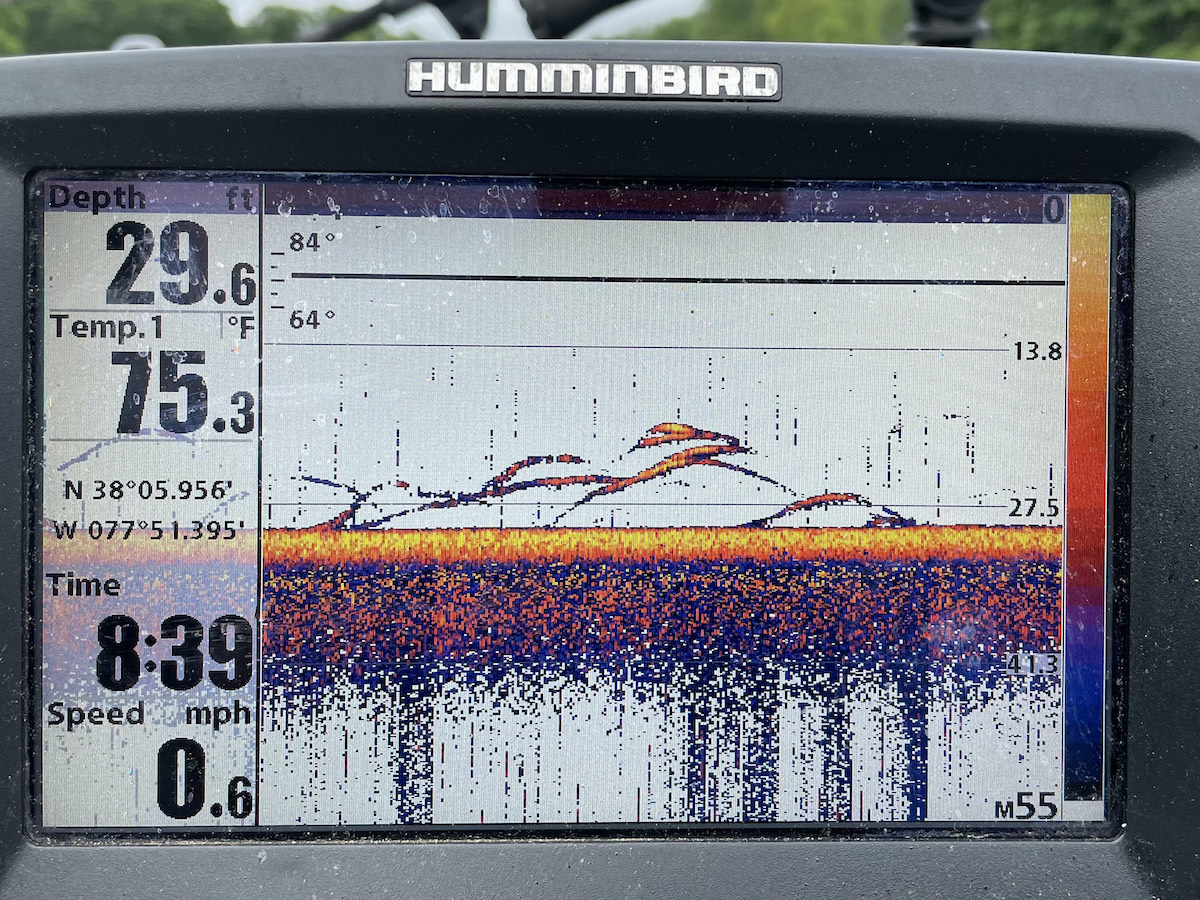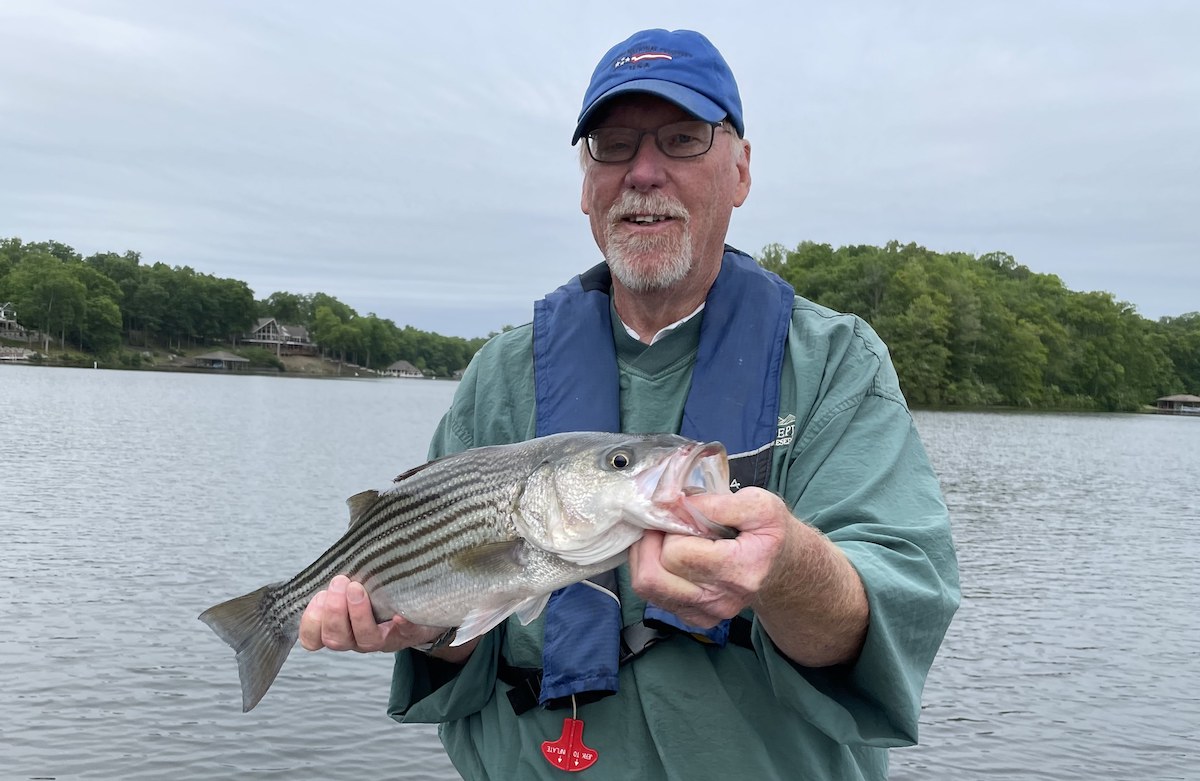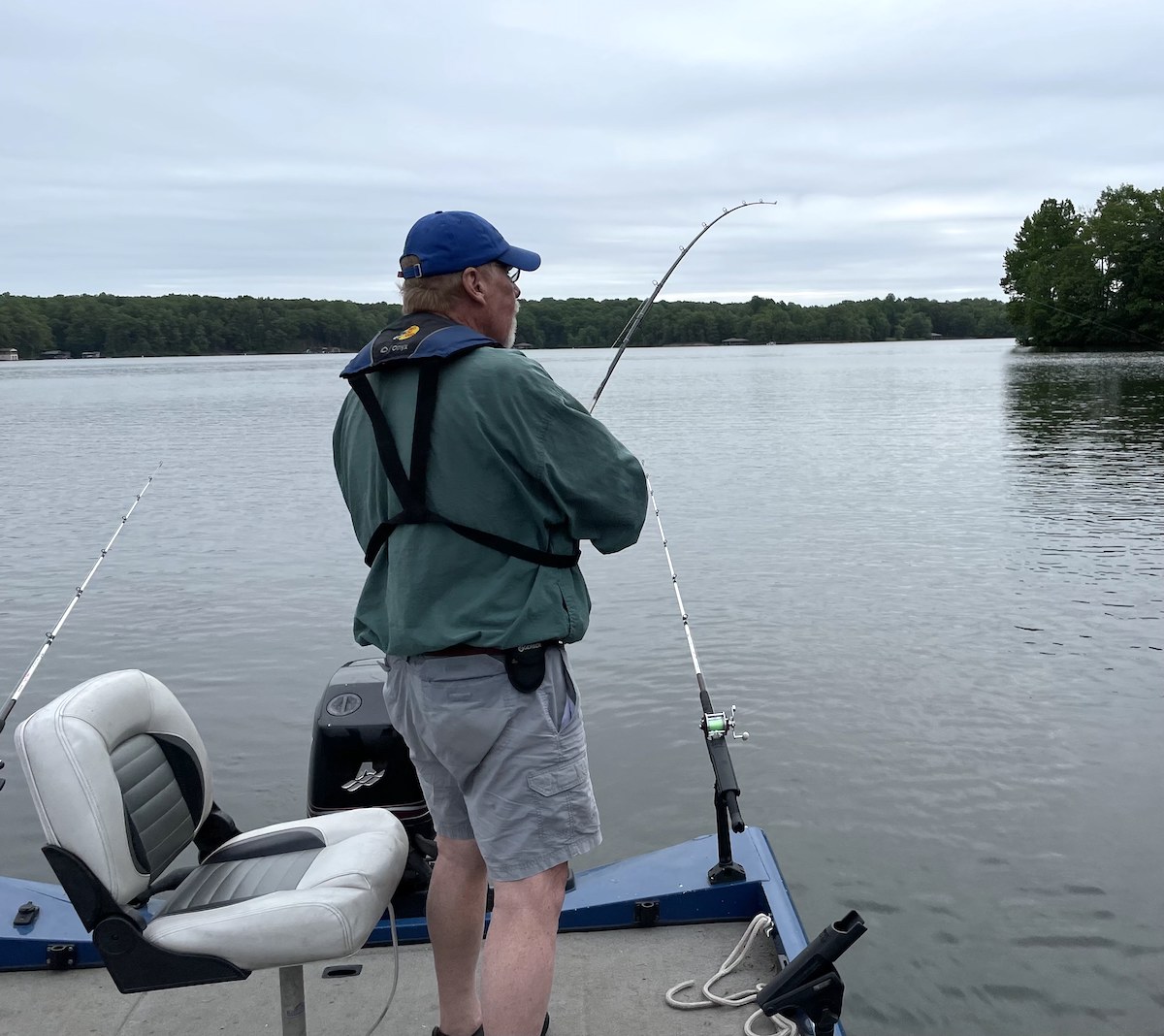
Bill Thompson and his planer board trolling setup on Lake Anna.
By Alex McCrickard, DWR Aquatic Education Coordinator
Photos by Alex McCrickard
When anglers think about striped bass in Virginia, the Chesapeake Bay and its tidal tributaries immediately come to mind. Or perhaps its surf fishing on the Eastern Shore or in the waves off Virginia Beach.
Striped bass are anadromous—spending most of their lives in the saltwater environment but returning to freshwater to spawn. However, in addition to our anadromous striped bass population in the Chesapeake Bay and along the Atlantic Coast, Virginia boasts some of the best inland land-locked striped bass opportunities you can find in the east. You don’t have to travel to the Chesapeake Bay or its tidal tributaries to find striped bass in Virginia. Large impoundments like Smith Mountain Lake, Buggs Island Lake, and Lake Anna, to name a few, provide excellent land-locked striped bass opportunities that some anglers overlook.
These land-locked striped bass fisheries exist due to the hard work of the Virginia Department of Wildlife Resources (DWR). Adult striped bass are collected each spring through electrofishing methods before being transported to DWR’s warmwater hatcheries. Hatchery staff then spawn the striped bass in controlled settings before raising the fish for roughly the first month of their lives. Thousands of juvenile striped bass are then transported and stocked into inland fisheries like Lake Anna in Louisa and Spotsylvania counties on an annual basis.
Lake Anna, a 9,600-acre impoundment owned by Dominion Energy, provides anglers with consistent striped bass fishing year-round and is an easy day trip from the D.C. metro area, Charlottesville, Fredericksburg, and Richmond. Striped bass on Lake Anna can be found schooled up chasing threadfin shad and blueback herring in open water. Having a dependable sonar unit is essential for finding these schools of stripers. Often it can pay dividends to locate a group of fish before getting your line wet. A group of long thick arches suspended in the water column on the sonar is a sure sign you have found stripers.

Looky there! Those arch shapes in the water column are a sure sign of stripers.
Local angler Bill Thompson, from Culpeper, is a Lake Anna regular. Thompson prefers to troll for stripers using planer boards. Thompson fishes with medium-heavy action 7-foot rods in a conventional setup with line counters. This allows him to drop his rigs down to the exact depth where he is marking fish. From there he clips his planer board on the line and lets more line out.
Planer board trolling is an excellent way to cover water and run numerous baits at once. While trolling, the pressure of the water on the planer board pushes the planer board out to the side of the boat. The more line you let out, the further out the planer board goes. Thompson prefers to have three lines out on both the port and starboard side of his boat. He prefers to run his back rod 65-70 feet off the boat, his middle rod 50 feet off the boat, and his bow rod 25 feet off the boat. Having his lines spaced like this allows him to run six baits at once and is the best way to avoid tangles. Thompson also often runs two lines off the stern, one at 30 feet and one at 40 feet with tennis ball-size floats with a bobber stopper set at 20-foot depth.
From here it’s a waiting game—you have to keep your head on a swivel watching the rectangular shaped planer boards push along. Planer boards are essentially like giant rectangular bobbers. When they move at a funny angle or go down, it’s the sign that you have a strike.

The planer boards in the water.
“I have found that spring and fall are really the best and easiest times of the year to catch a limit of stripers,” said Thompson. “And we are lucky on Lake Anna with a four fish over 20-inch limit. I really like using live baits, generally extra-large golden shiners, which are available at the marinas.”

Bill Thompson with a Lake Anna striper.
In addition to golden shiners, some anglers prefer to troll with blueback herring when they can find them. Catching bluebacks can be challenging and is often done with a cast net in the dark of night. Look for bluebacks to be congregating around bridge pilings in the early morning hours before the sun comes up.
“The tackle setup I use is pretty stout for freshwater, but when a striper takes your bait it’s not unusual to see the rod tip dip to the water. They hit like a freight train!” said Thompson. “I use 20-pound mono running line with a 1-ounce egg sinker to a swivel with a 3 to 4-foot, 15-pound fluorocarbon leader and 1/0 circle hook on the end. The reason for the lighter leader is so when you hang up, you don’t lose all your tackle and planer board,” said Thompson. Additionally, circle hooks are better for the stripers and are an excellent way to prevent gut-hooking fish.
“While putting baits down I set the remote control trolling at one mile per hour and set the heading straight. Once the baits are down I generally slow down to 1/2 – 3/4 mph. I watch the graph and see how the fish react. Sometimes they want a fast bait and sometime slow,” said Thompson.
Thompson recalls having as many as five rods go down at the same time on really productive trips. “This is what you call a good cardio workout as your heart rate goes up and you thank whoever invented circle hooks,” he said. Thompson has spent a lot of time on Anna learning how the stripers move through the lake throughout the duration of the year. “Early in the spring around February and March they will be up in shallow water in 4 to 5 feet,” he said. As the water warms up, the stripers move down the lake into deeper water. “In the heat of summer when the lake warms up to 85 and 90 degrees, you can usually find them in the deep creek channels in 30 to 60 feet of water,” said Thompson.

Bill Thompson in action on Lake Anna.
You can also have success casting artificial lures like swimbaits off points and in the areas you are marking fish. It’s important to pick the size and color swimbait that matches the forage the stripers are feeding on. Typically, 3.5″ to 5″ lighter-colored swimbaits are a good blueback herring imitation. For fly anglers, consider fishing a 350-grain full sinking line on an 8-weight rod if you are marking fish in 15 to 25 feet of water. A good choice to mimic the abundant blueback herring forage base is 3.5-inch to 5-inch clouser minnows in gray and white. In the fall the stripers can sometimes push a school of bluebacks to the surface in a feeding frenzy. This can provide for exciting site fishing to breaking fish.
John Odenkirk, fisheries biologist with DWR, has been managing Lake Anna for more than 30 years. “Anna is a wonderful fishery given the habitat,” he said. “Large, adult stripers prefer cool, highly oxygenated water, and that’s just not here. However, thermal stratification patterns due to power plant operation prevent formation of a traditional thermocline in many areas, providing fish with water quality adequate for juveniles and young adults. This, along with a large forage base consisting of three clupeids, allows Anna to provide great angling for fish up to 28 inches, although smaller fish are more common due to slow growth. We’ve recently begun adding hybrid striped bass to annual stockings, and these fish are more tolerant of warm water and should do very, very well in Anna. In fact, I’m hoping for a state record in a year or two!”

The author with a striper from Lake Anna.
To access Lake Anna you can use the public boat ramp at Lake Anna State Park located on the north side of the lake in Spotsylvania county. There are also a handful of private marinas and campgrounds that provide access to the lake with a daily launch fee. Bank anglers can fish from the shore at DWR’s Dike 3 access. While the fishing platform has been removed at Dike 3, shoreline fishing is still available.
In addition to the striped bass and hybrid striped bass fisheries, Lake Anna has a diverse fish community including strong populations of largemouth bass, black crappie, bluegill, channel catfish, and white perch. Some saugeye are present in Lake Anna too, and recent stockings should help boost that population.
To learn more about scenic Lake Anna and the fishery visit our website at https://dwr.virginia.gov/waterbody/lake-anna/.


